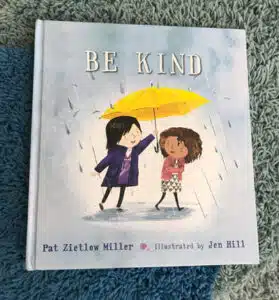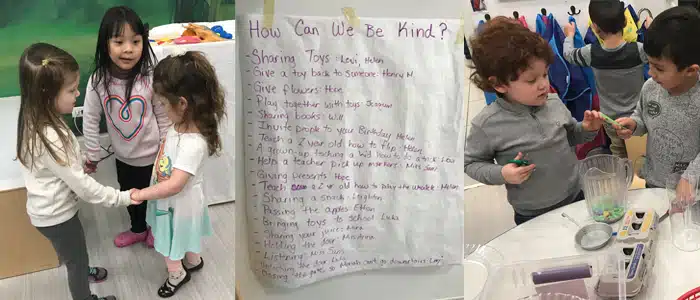Cultivating Kindness in young children can seem like an impossible task at times, in large part because developmentally the brains of toddlers and preschoolers are still forming the neural connections that help them to understand that other people have feelings, opinions, and thoughts that are different from their own. They are also still working toward developing the part of their brains that helps them to control impulses and understand that their actions can have consequences. However, with careful facilitation, there is so much that we can do to scaffold the development of empathy and help Cultivate Kindness.
Each year, right around the time fall begins to turn to winter, I always begin to notice my four and five year olds getting a bit carried away with bossing each other around, are getting into more arguments, and are using not so nice words with their classmates and teachers. This is my cue to start bringing attention to any act of kindness I notice throughout the day, no matter how small. Something like “Wow! I just noticed that my friend Max is helping to put away the legos today, even though he didn’t play with them. That is so kind of you, Max. Thank you.” Or “Thank you for picking up that marker I just dropped. That was very kind.” Or “I just heard someone use their very kind words to ask a friend to give them some space right now.” Until eventually someone finally asks “Miss Sam, what does kind mean??” And we’re off on our journey to Cultivate Kindness.
The Journey to Cultivate Kindness
As with any big question that comes up in my classroom, we start with a Circle Time discussion about the topic. First, I explain that kindness can be a lot of different things. It can be helping someone, using nice words, making something, or just noticing what’s happening around you. It makes you feel good to be kind. Then I ask, “What kinds of things can we do at school that are kind?” Then, because I never miss an opportunity to imbed literacy in anything we do, we make a big list of everyone’s ideas. After we make our list, we read the book “Be Kind” by Pat Zietlow Miller, 
This past week I noticed two instances that prove that we’re succeeding in creating the neural connections needed to help these tiny humans turn into empathetic, kind and caring adults. After school one day, a child was very sad that the puppet he made had gone missing. Then, without missing a beat, his classmate said “You can have this one I made. I made two!” And taking into consideration the strong emotional connections children have with the things they make themselves, this act of kindness was truly selfless. Then, at lunchtime we were having a particularly messy batch of pasta (giving everyone quite the sauce-stache), and a student went into the bathroom to wipe off her face. She came out with a stack of paper towels and asked each person at the table “Do you want a napkin, too?” Now, this was the absolute best way to get a dozen 4 year olds to wipe their faces without protest and without any help from an adult.
Cultivate Kindness at Home
Let’s teach our children to be kind
Encourage Self-Acceptance
Research shows that children who bully others often do so because they are unhappy with themselves and want to deflect the attention. Talk to your child about what makes them different and unique, and encourage them to celebrate these differences. When Lori’s daughter was picked on because she was short, she wrote a book “Being Small (Isn’t So Bad After All)” so show her she is special. Books are a great way to promote self-acceptance.
Build A Healthy Dose Of Self-Confidence
Praise your child for their intelligence, personality, appearance and abilities. Celebrate their wins with them, and let them know it is OK to come in second, or even fail. Be a shoulder to cry on when they do.
Teach Empathy
Acknowledge to your child that not everyone is the same as them and that it is okay. Role play and ask them how they might feel in someone else’s shoes. When they can understand empathy, they will learn to genuinely care about others.
Highlight The Golden Rule
Reinforce to your child that we should treat others the way we want to be treated. Remind them that everyone is fighting a battle we know nothing about. Do they ever notice a classmate sitting alone at lunch? Suggest they show small acts of kindness that can yield big results.
Stress The Importance Of Inclusion
Has your child talked about another classmate who is withdrawn? These kids are likely the targets of bullies. Encourage your child to show they care by acknowledging and including them. It can be as simple as inviting them to sit together at lunch, or play together at recess.
Raise Upstanders, Not Bystanders
Even if your child isn’t bullying anyone, acting as an audience for the bully and saying nothing is just as bad. Often times, bystanders don’t know what to do. Speak to your child about the importance of using their voice to take action to tell the bully to stop or to report the behavior to an adult.
Speak Nicely About Others, And Yourself, Too
A child’s mind is like a sponge – they absorb everything. Make a conscious effort to only let your child hear you speak about others – as well as yourself – in a nice way.
Model Positive Behavior
Children take cues from their parents, so what you do is more important than what you say. Let your kids see you opening the door for strangers or giving up your bus seat for someone who is elderly. Simple, kind gestures like this help you role model the behavior you want to see from your kids.
Give Back
Whether it is organizing a toy drive for needy children or serving meals to those less fortunate, provide meaningful opportunities for your child to experience giving back in the community.
Keep The Conversation Going
Schedule an informal “check in” with your child to talk about their friendships at school. Take them out for ice cream, and show genuine interest in their day-to-day life at school.
“When I was a boy and I would see scary things in the news, my mother would say to me ‘ Look for the helpers, you will always find people who are helping.’ To this day, especially in times of ‘disaster’, I remember my mother’s words and I am always comforted by realizing there are still so many helpers- so many caring people in this world.”
I find so much comfort in knowing that we are helping to shape the next generation of kind and caring helpers. I hope you do too.

Samantha Perry
Samantha Perry is the Director of Bubbles Academy’s Arts-Integrated Preschool Program. She is also the recipient of the Harris Foundation’s Scholarship for Excellence in Leadership and received her Master of Science in Child Development with a specialization in Administration at Erikson Institute. The Harris Excellence Scholarships are awarded annually to a select number of students with excellent academic credentials and a demonstrated commitment to the field of early childhood.
Sam is grateful for the opportunity to use both her theatrical expertise, and broad knowledge of needs of young children at Bubbles Academy’s arts-integrated preschool program. As an educator, Sam strives to inspire confidence, independence, curiosity and creativity in each of her students every day.
